At the tail end of 2021, Canyon launched the all-new Torque. Up until that point, the Torque came only with 27.5in wheels. However, that’s all changed for 2022 and the new bike gets a place on our Endurance Bike of the Year shortlist.
There are now three different options to choose from, including a dedicated 27.5in-wheel bike, a 29in version or, as you can see here, a mixed-wheel-size or ‘mullet’ option that uses a 29in front wheel and 27.5in rear wheel.
Understandably, at the point of pulling this test together, Canyon was tight-lipped about the new Strive, which launched recently, and unfortunately, we weren’t able to include it in this test.
Yes, the Torque is more of a ‘bikepark shredder’ than a full-on enduro race machine. But its do-it-all credentials have always stood it in good stead, even taking it to the top slot of our Enduro Bike of the Year test back in 2018. That meant hopes were still high – and thankfully, we weren’t disappointed.
Canyon Torque CF8 frame and suspension details
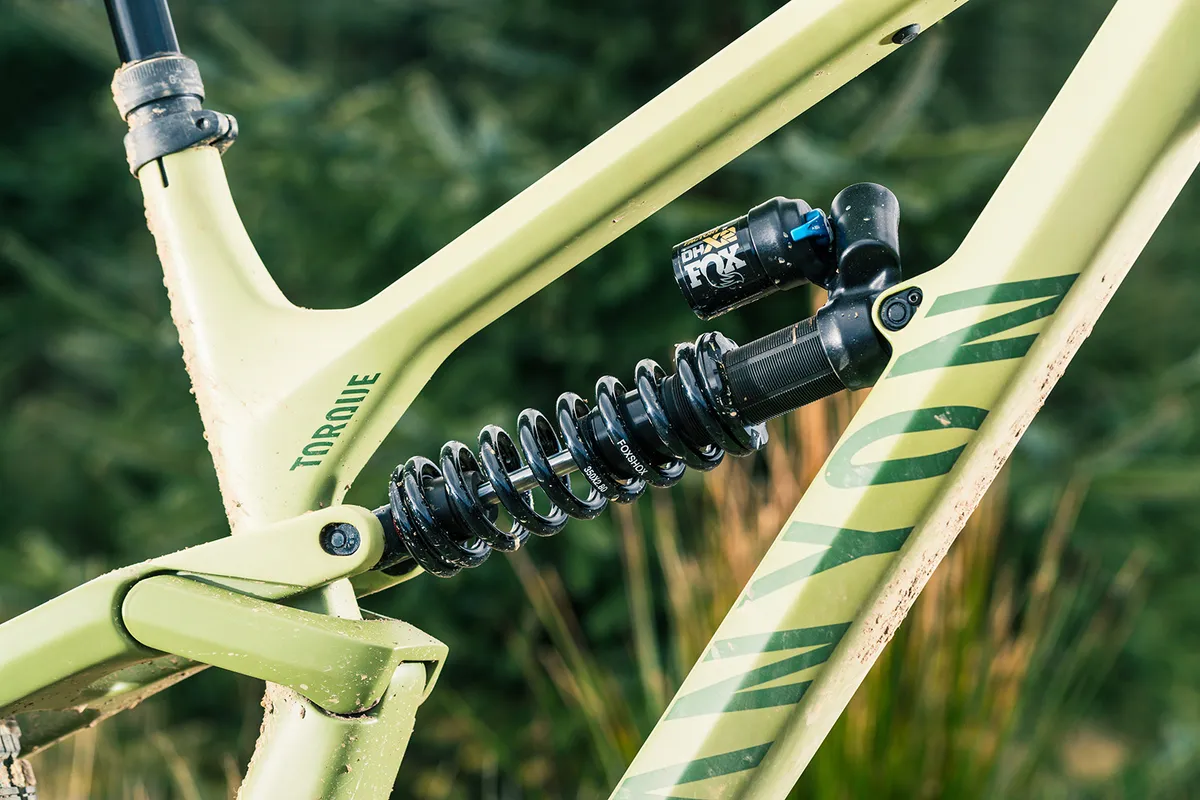
At the point of writing this review, Canyon doesn’t offer the ‘mullet’ version of the Torque in anything other than carbon (both the dedicated 27.5in-wheeled bike and the 29er are available with aluminium frames as well) and there are only two build options, the cheapest of which you see here.
But, despite the pricier material and any fears around its durability, it’s worth remembering that Canyon has constructed the Torque's frame to adhere to its ‘category 5’ rating.
This, according to Canyon, is reserved for its toughest bikes (including its DH bike, the Sender), so in theory at least, this carbon frame should be built to take the biggest of beatings imaginable.
Despite meeting that robust standard, Canyon claims the new carbon frame weighs 200g less than the previous model.
To help tame whatever wild mountain trail or bikepark track you’re throwing the Torque down, Canyon has equipped it with 175mm of rear-wheel travel.
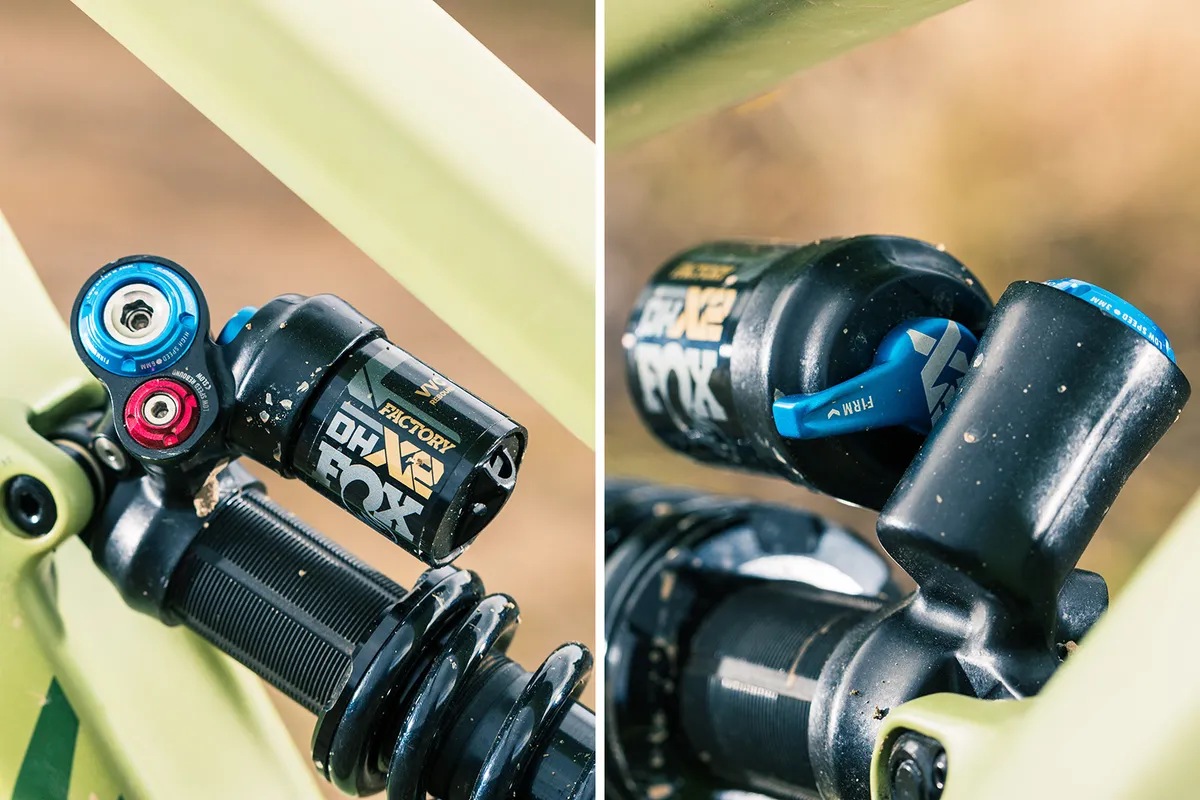
This is controlled using a four-bar linkage and designed using the brand’s ‘Triple Phase’ (soft early on in the travel, supportive through the middle then ramping up at the end) concept.
As you can see from the pictures, there’s enough progression built into the system that the Torque can easily be used with a coil-sprung shock.
Anti-squat has been upped at sag point in order for the bike to feel a little more pedal-friendly when climbing.
Canyon always manages to deliver on the details and the Torque is a prime example of this. Really nice smaller aspects include the removable cable ports that screw into the frame for ease of maintenance, yet stay secure and help prevent any annoying rattles.
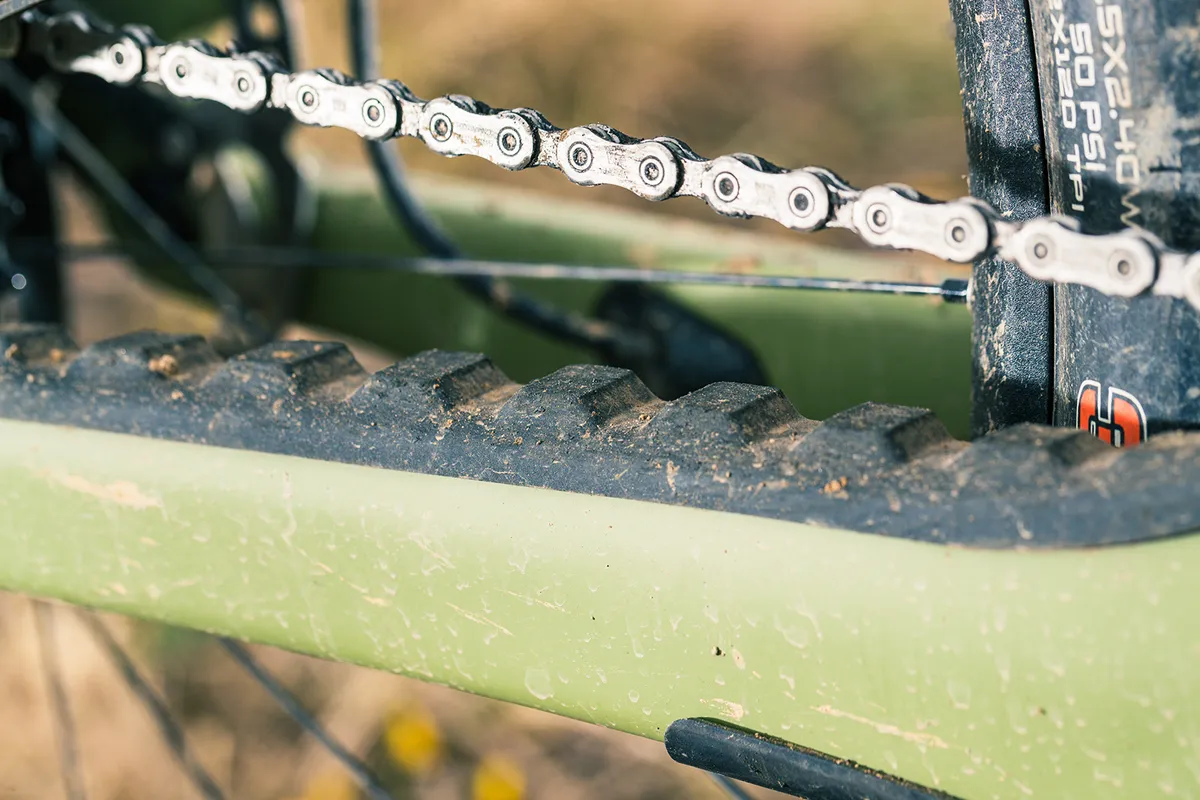
There’s also the neat, tool-free rear axle, where the hinged lever used to unwind it telescopes into the axle itself when not being used.
Other useful touches include having all linkage bearings accessed from the non-driveside, while the pivot threads are mounted on replaceable inserts (on the carbon frames), so can be replaced if the maintenance does take a turn for the worse.
There’s also plenty of integrated rubberised frame protection in all the key areas, including the heavily shaped chainstay protector, which is designed to calm chain slap.
Canyon Torque CF8 geometry
Like a number of other brands, Canyon doesn’t offer the mixed-wheel-size version of the Torque (or the full 29er spec) in a size small.
Its geometry chart states that the medium (seen here) will work for riders between 172 and 185cm – so if you’re below that, you might want to look at the 27.5in-wheeled equipped offering, where a size small does exist.
With a 430mm seat tube though, there may still be hope for shorter riders wanting to ride a mullet-style Torque.
I’m 172cm, so right on the limit, and have short legs. I had no issues with the combined height of the seat tube and the adjustable-travel dropper post set to use its full 170mm scope (maximum travel is 170mm for the medium frame, but you can reduce it by 25mm in 5mm increments).
You’ll need to be comfortable with the generous 465mm reach on the medium, though. Canyon has trumped many other brands in this department, stretching the Torque out quite a distance compared with other top performers.
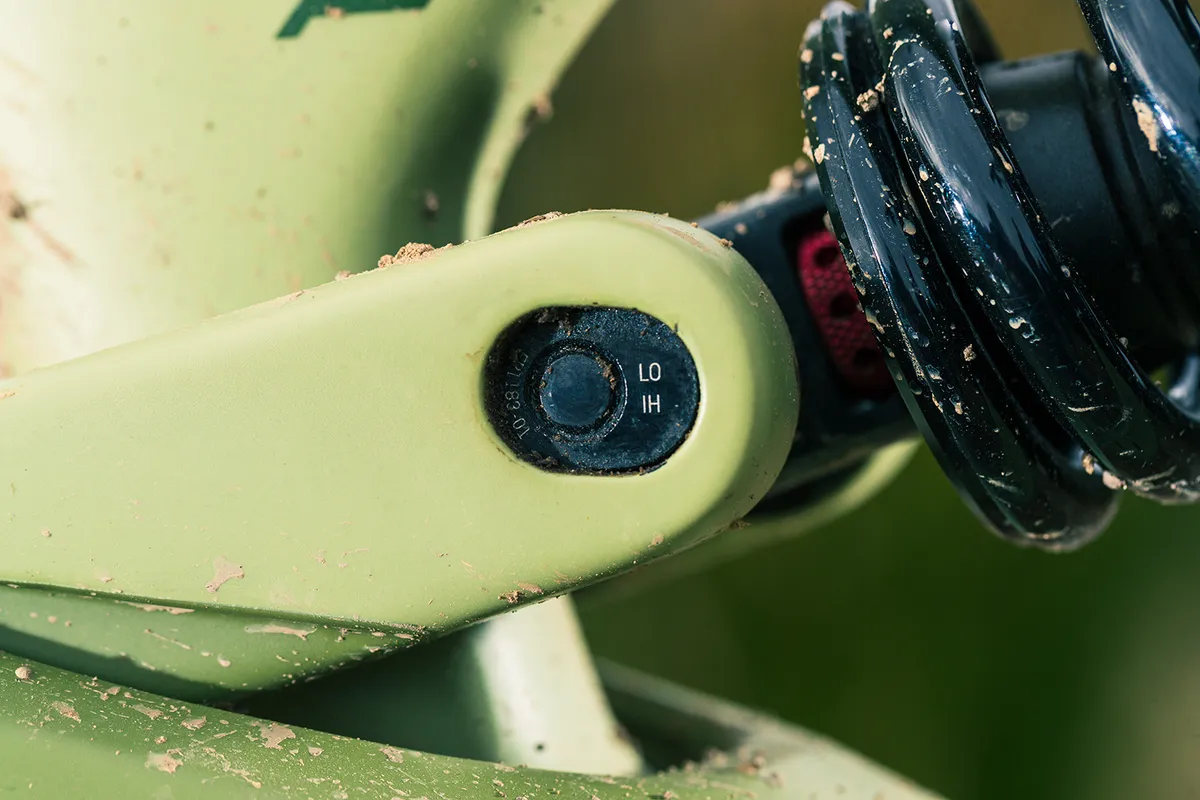
Thanks to the oval flip chip that sits at the base of the rear shock, you can alter the Torque’s geometry, depending on rider preference or terrain type.
Switching between the high and low settings changes the head and seat tube angles by 0.5 degrees and will shift the bottom bracket up or down by a reasonably substantial 8mm.
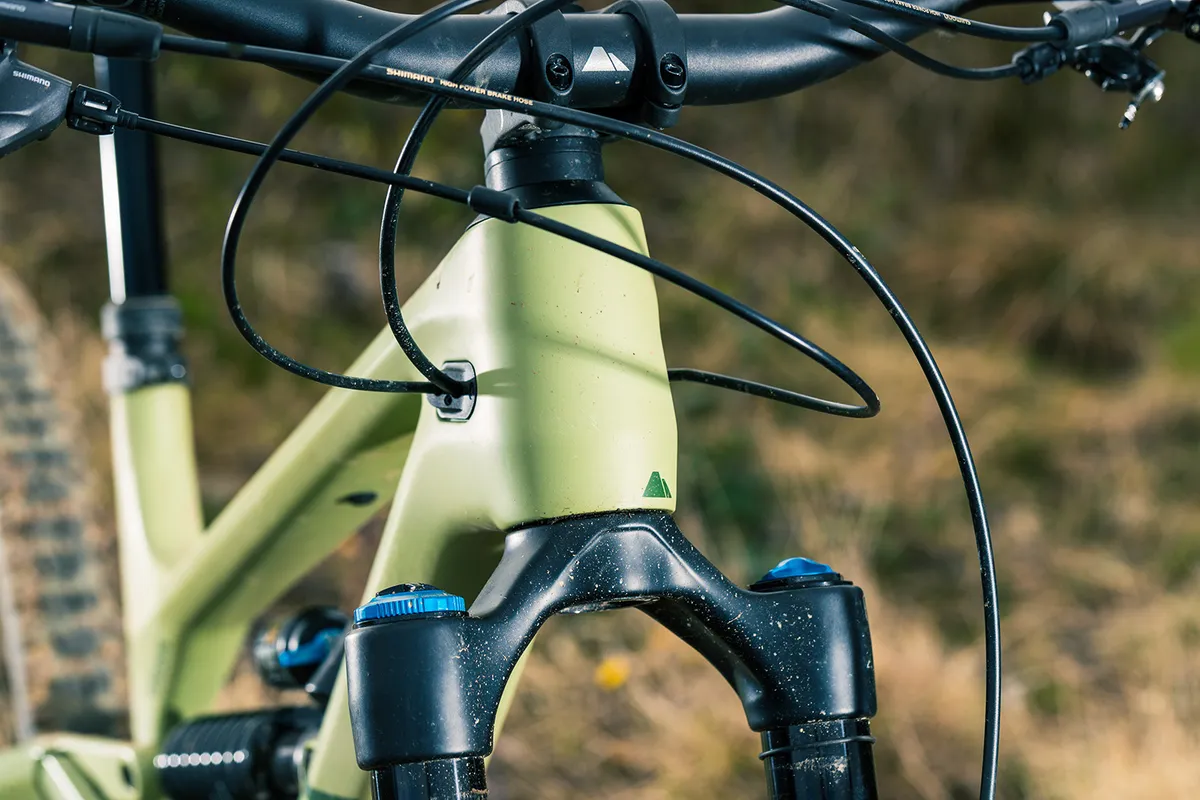
In the low setting, I measured the head angle to be a very slack 63.2 degrees and the effective seat tube angle to be steeper than claimed (with the saddle set at my preferred pedalling height) at 78.1 degrees.
The lengthy 810mm front centre (horizontal distance from the centre of the bottom bracket to the centre of the front axle) is paired up to a 435mm rear centre.
| | M | L | XL |
|---|---|---|---|
| Seat angle (degrees) | 77.5 | 77.5 | 77.5 |
| Head angle (degrees) | 63.5 | 63.5 | 63.5 |
| Chainstay (mm) | 435 | 435 | 435 |
| Seat tube (mm) | 430 | 445 | 460 |
| Top tube (mm) | 604 | 631 | 658 |
| Head tube (mm) | 105 | 115 | 125 |
| Bottom bracket height (mm) | 335 | 335 | 335 |
| Wheelbase (mm) | 1,248 | 1,277 | 1,307 |
| Standover (mm) | 787 | 789 | 794 |
| Stack (mm) | 629 | 638 | 647 |
| Reach (mm) | 465 | 490 | 515 |
Canyon Torque CF8 specifications
All the parts bolted onto the Torque are great choices and help create a really dependable, well-functioning bike that’s comfortably up to the task at hand.
Shimano’s XT 12-speed gearing offers a decently wide range thanks to the 10-51t cassette, and I’ve always got along well with its shifting (and particularly like the multi-release feature on the XT shifter).
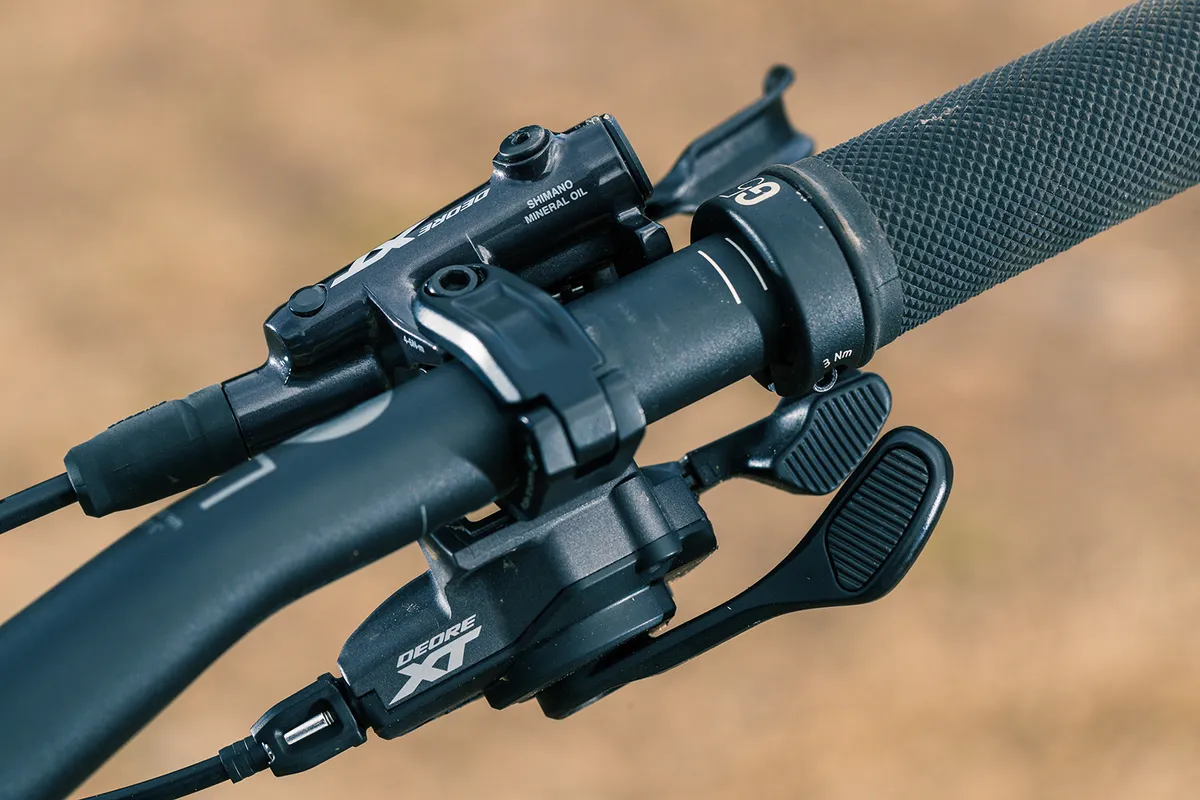
The brakes also come courtesy of the Japanese brand’s XT stable. The M8120 brakes use the stubby, Servo Wave-equipped levers to squeeze the four pistons inside each caliper, and clamp onto 203mm rotors at either end.
My rear brake didn’t have a great bleed, which led to a wandering bite point. After re-bleeding it, it remained consistent throughout testing.
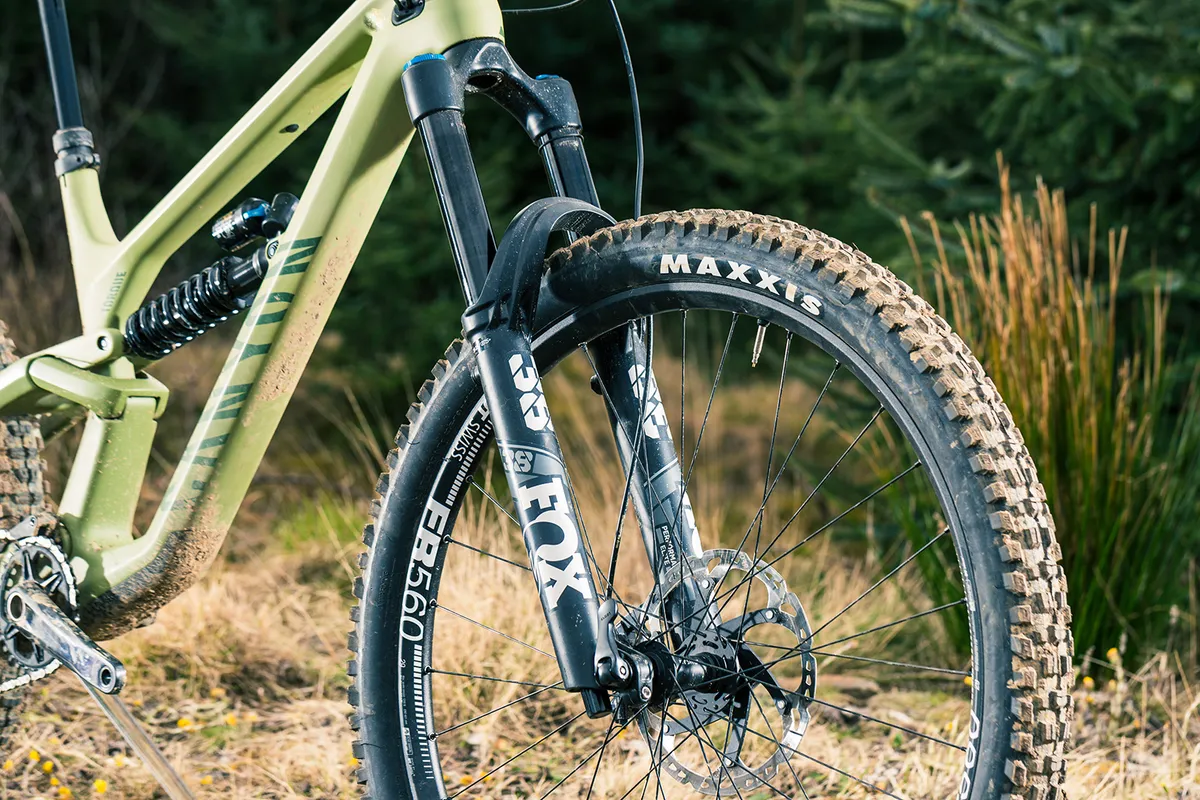
Up front, the Torque uses the Fox 38 Performance Elite fork to deliver 170mm of travel. Despite the lack of Kashima-coated upper legs, which you get with the top-spec Factory version of the fork, it does still include the GRIP2 damper with both high- and low-speed compression and rebound-damping adjustment.
The shock, however, is the Factory-spec DHX2 coil number. While you can’t tune the spring rate as easily on the coil as you can with an air-sprung shock, Canyon does provide two different springs (along with the one fitted to the shock), so you at least have the ability to change things to suit.
You also get the same high- and low-speed compression and rebound-damping adjustment as on the fork, along with a low-speed compression lever that will help firm the back end of the bike up for climbing efforts.
DT Swiss FR 560 freeride rims are fixed to the same brand’s 350 hubs and come wrapped in Maxxis rubber. The tyres in question are the Assegai 3C MaxxTerra EXO+ 29x2.5in at the front and the Minion DHR II 3C MaxxGrip DD 29x2.4in at the rear.
Canyon supplies its own G5 bar, stem, grips and dropper post, which you can alter easily to deliver different amounts of travel. It’s all quality stuff and works really well in my experience.
Canyon Torque CF8 ride impressions
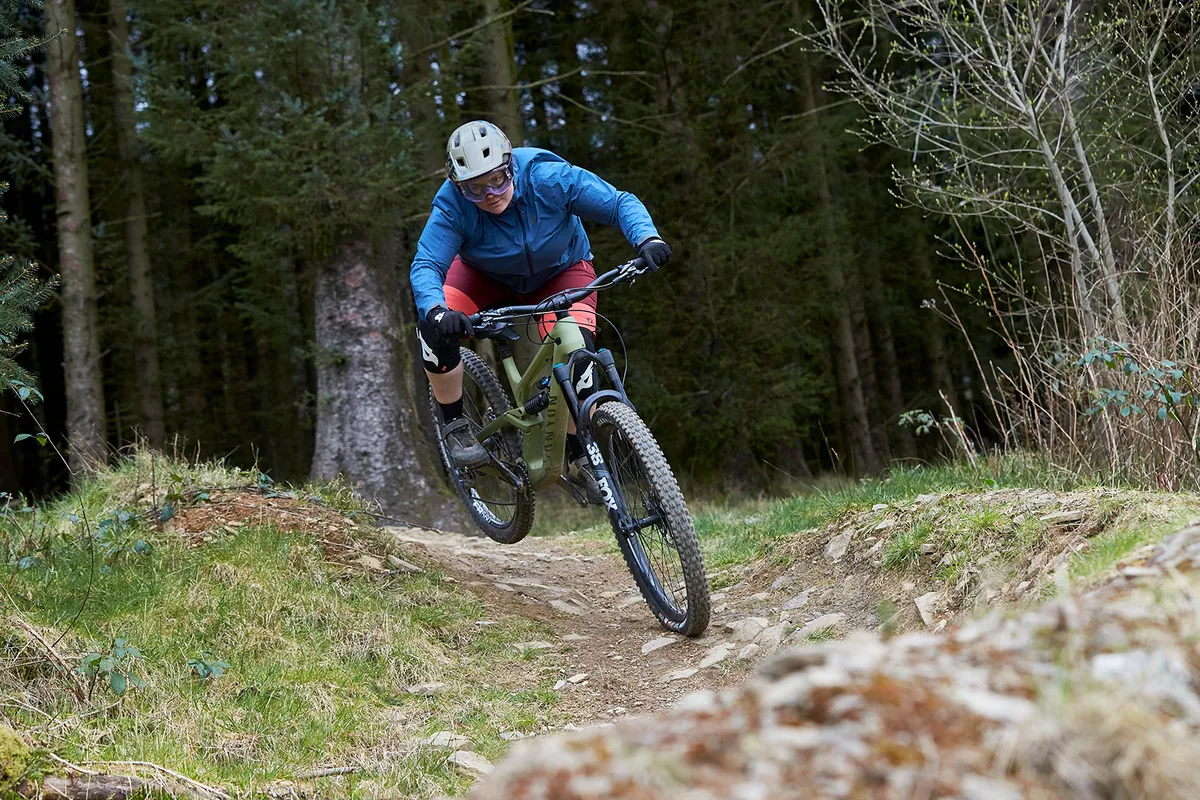
Getting to grips with the Torque meant riding it in a number of different locations to try to get the most out of the bike and see if I could push it to its limits.
That involved hammering down smooth jump trails, sliding down technical natural singletrack and banging out laps on some super-fast bikepark-style tracks, where the hits come thick and fast.
Setting up the Canyon Torque CF8
Although Canyon supplies additional coil springs for the DHX2 shock, I stuck with the 350lb spring that came stock on the bike.
This gave me 30 per cent sag. I then set the low-speed and high-speed compression damping fully open, with 10 clicks of low-speed rebound (from fully closed) and the high-speed rebound fully open.
At the front, I settled on 80psi in the spring and finished with two tokens to reduce the air volume and make the fork a little more progressive.
This was mainly down to trails drying out over the course of the test period, and me feeling more confident and happier to push the bike harder.
Both rebound and compression-damping adjustments were fully open on the fork.
Canyon Torque CF8 climbing performance
Even with the Torque’s sticky front tyre, there’s an eagerness to proceedings when it’s pointed uphill.
That’s not to say this big-travel monster is going to have you ripping past Lycra-clad cross-country riders, but compared with some of its closest competitors, it’ll make comfy progress up any climb you take on.
There’s not much in the way of suspension-induced bob while you’re sitting down and spinning the cranks, and the steep effective seat tube angle does a great job of keeping your hips over, rather than behind, the bottom bracket, for an easier, more efficient pedalling position.
At 604mm, the effective top tube is reasonably lengthy for a size medium. Coupled with the 40mm stem and steep seat angle, the Torque encourages quite an upright seated position, but because the head angle is so slack and the front axle a decent distance ahead of you, I never found myself having to drastically shift my weight forward on really steep climbs, which was a bonus.
And while the shock’s lever is easy to reach, I didn’t bother touching it when going uphill, because the Torque never seemed to be sinking too deep into its travel or moving excessively enough to make things really feel like hard work.
Instead, keeping it open only added to comfort and helped boost traction when tackling loose surfaces.
I certainly appreciated the wide-range Shimano cassette, along with the fact that the XT drivetrain handled sloppy shifting under power.
Canyon Torque CF8 descending performance
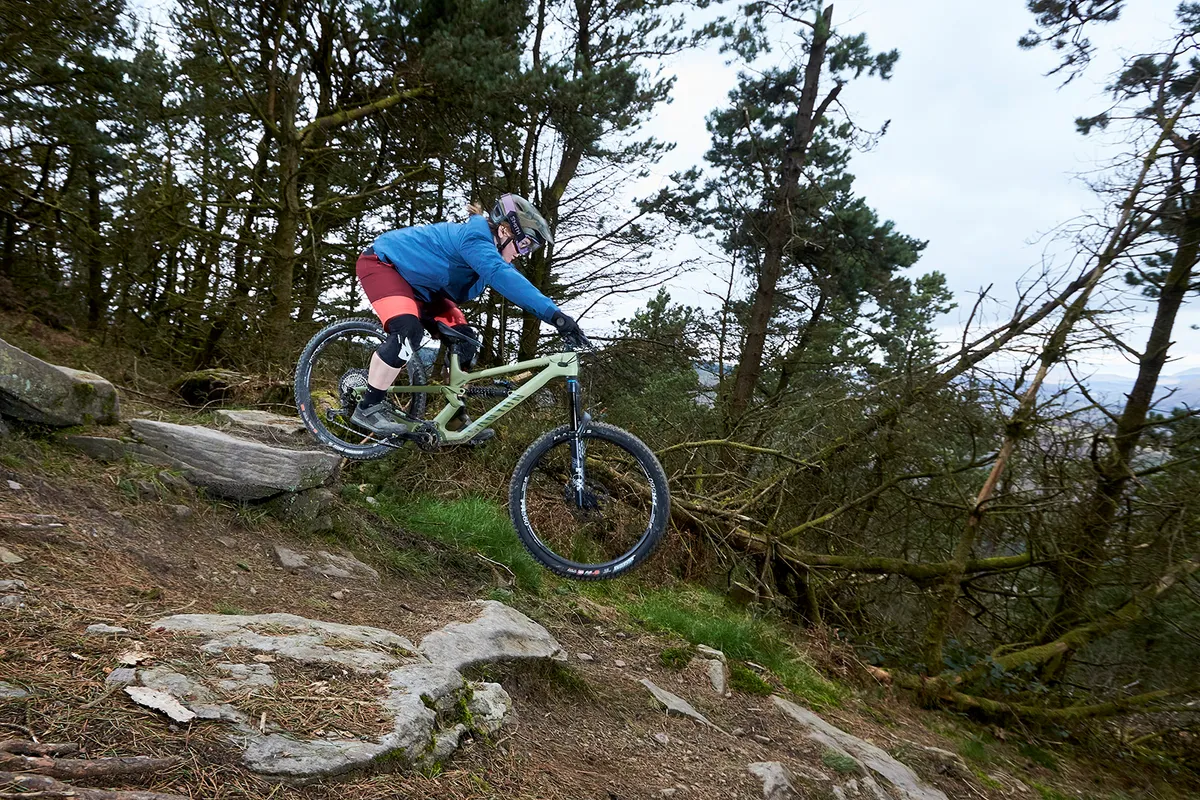
From the very first pedal stroke downhill, it was clear the Torque can deliver fun by the bucketload.
As you drive your weight down through your hands and feet, the support on offer as you pump the trail’s undulations ensures you generate speed instantly.
Hit the first lip and that support translates to pop, which means getting this long-travel big-hitter airborne is easier than both its travel and geometry figures might suggest.
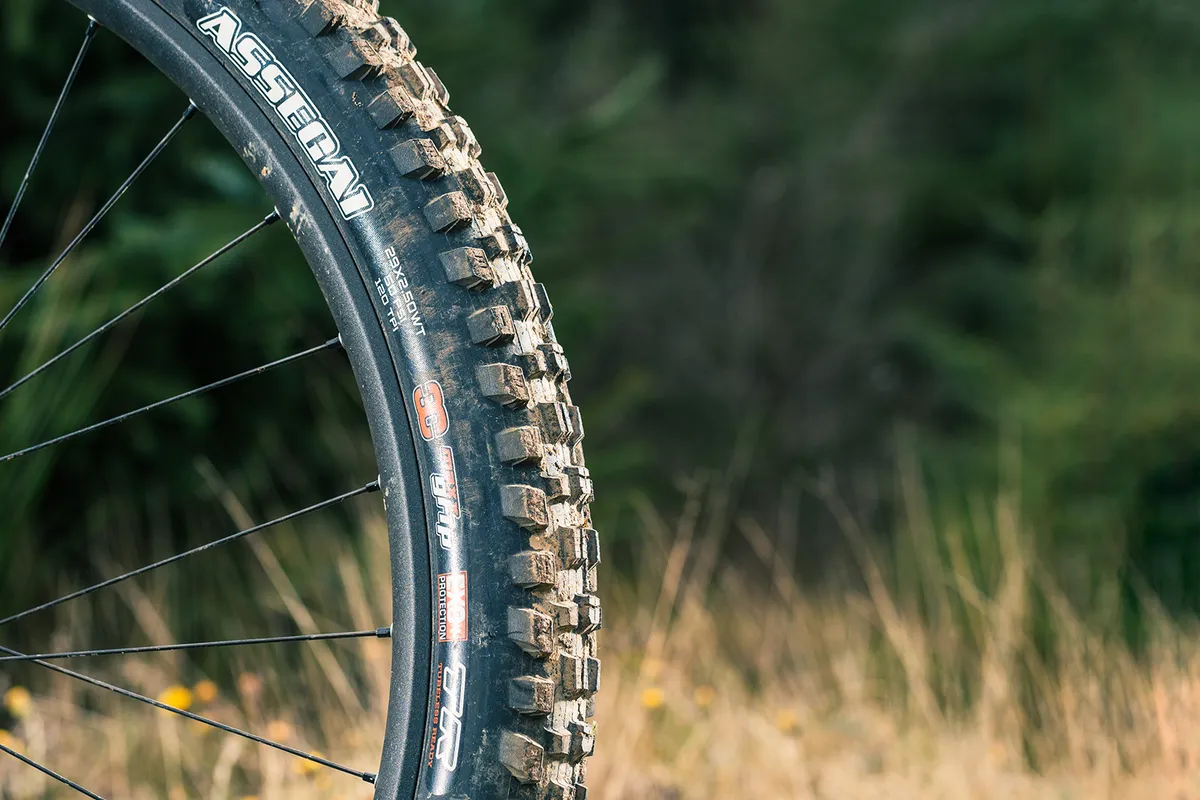
It’s an easy bike to adapt to, with well-balanced geometry and suspension. Coupled with the choice of tyres, this means there’s a surefooted predictability about how the Torque behaves, with no awkward quirks or irregularities to throw a spanner in the works when it comes to trail flow.
As a result, it’s easy to push yourself out of your comfort zone when faced with fast, jump-strewn tracks, where the Torque offers an easy-to-handle ride with more than enough suspension travel to soak up heavy landings.
There’s a nice amount of ramp-up at the rear too, when you do really thump into the floor. Even on some nasty, slightly off-line landings, while I may have maxed out the travel, I never once felt any harsh bottom-outs.
Throughout, the back end of the bike remained controlled and only seemed to use the travel necessary at the time, never anything extra.
It’s fair to say that when it comes to riding bikepark-style jump lines, the Torque is one of the best out there.
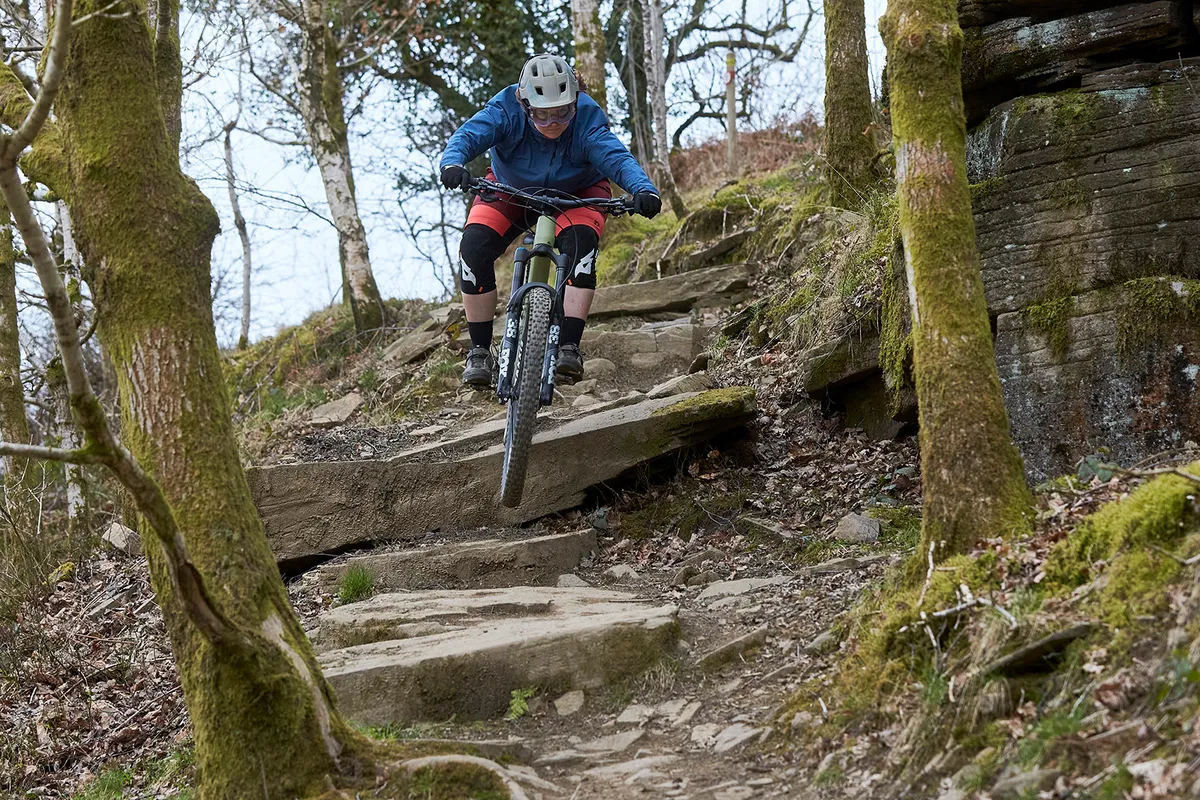
Of course, it’s rare anyone will only ride one type of trail over and over again, never deviating onto something more natural, rocky and rooty.
When the Torque does get stoved head-on into the chunder, the back end patters over the bumps in almost complete silence.
That said, while it has a lot of travel on tap, the Torque isn’t a bike that appears keen for you to simply drop your heels and bulldoze through the chatter. It’s more communicative than that.
While the suspension does a great job of taking the edges off the nastiest impacts, it doesn’t swallow them in the same way as peers such as the Whyte G-180 RS MX or Nukeproof 297 Carbon Elite, which isolate the rider a little better from what’s going on beneath the tyres.
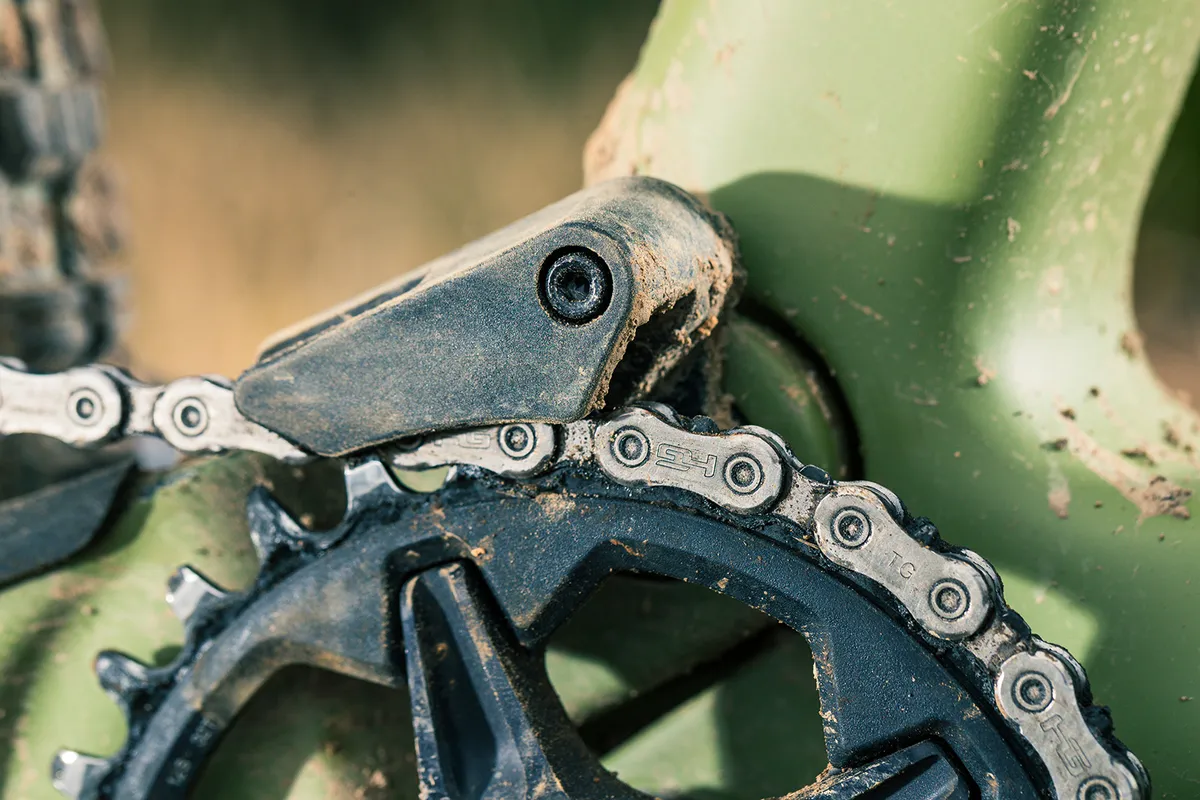
I’m not saying for a minute that the Torque is a rough ride, but compared with those particular bikes, there’s a touch more feedback through the feet and hands when tackling really bumpy terrain.
The fork feels as though it needs a tune-up too, because it’s a little over-damped (hence the adjusters remaining open for my 68kg weight). It doesn’t feel as forgiving as the likes of the RockShox ZEB, for example, when battering through repetitive hits.
It still remains impressively sensitive at the start of the stroke and it’s only when faced with fast, continuous impacts through rock gardens that you start to feel it in your hands.
Yes, I’m being picky here, but only because I think there’s scope to get it working even better.
Out back, the shock setup (I like both the fork and shock to rebound quite quickly) made me question my settings somewhat.
When I was having to lift the bike up and pop it over an obstacle, there would be, on occasion, a very slight top-out as the rear shock extended quickly.
Adding more high-speed rebound damping did help this, but because it wasn’t a regular occurrence and didn't affect how the bike behaved, I soon opened things back up to get the bike feeling exactly as I prefer.
In steep, natural terrain where speeds are inevitably reduced, I was consistently impressed by how controlled and composed the Torque felt.
The bike manages to maintain its dynamic geometry brilliantly when pointed down something ludicrously steep, all the while helping you to stay where you need to be between the wheels.
It helps that the brakes are light to the touch, but brutally crisp and powerful. When combined with the traction on offer from the Maxxis rubber, this means you can quickly jab the brakes, adjust your speed and manoeuvre the bike any which way required in a split second.
That certainly helps reduce arm fatigue on lengthy steep sections, where you’re likely to be dragging brakes for extended periods of time.
Through rougher turns, the Torque isn’t quite as planted or glued to the ground as some though, skipping over rather than ploughing through chunder – which does make for a more engaging ride experience at times. But it’ll still corner superbly, requiring very little in terms of rider input to get you through tricky turns.
How does the Canyon Torque CF8 compare?
While the Canyon has a similarly supportive feel to the Propain Tyee AL 29, its geometry and handling mean it's able to out-perform it on steeper trails or when the pace picks up.
Compared to the Nukeproof Giga 297 and the Whyte G-180 RS MX, while the Torque feel more playful and fun on some trails, and more eager to be picked up and popped, the Whyte and Nukeproof are a little more forgiving when the going gets rough.
Canyon Torque CF8 bottom line
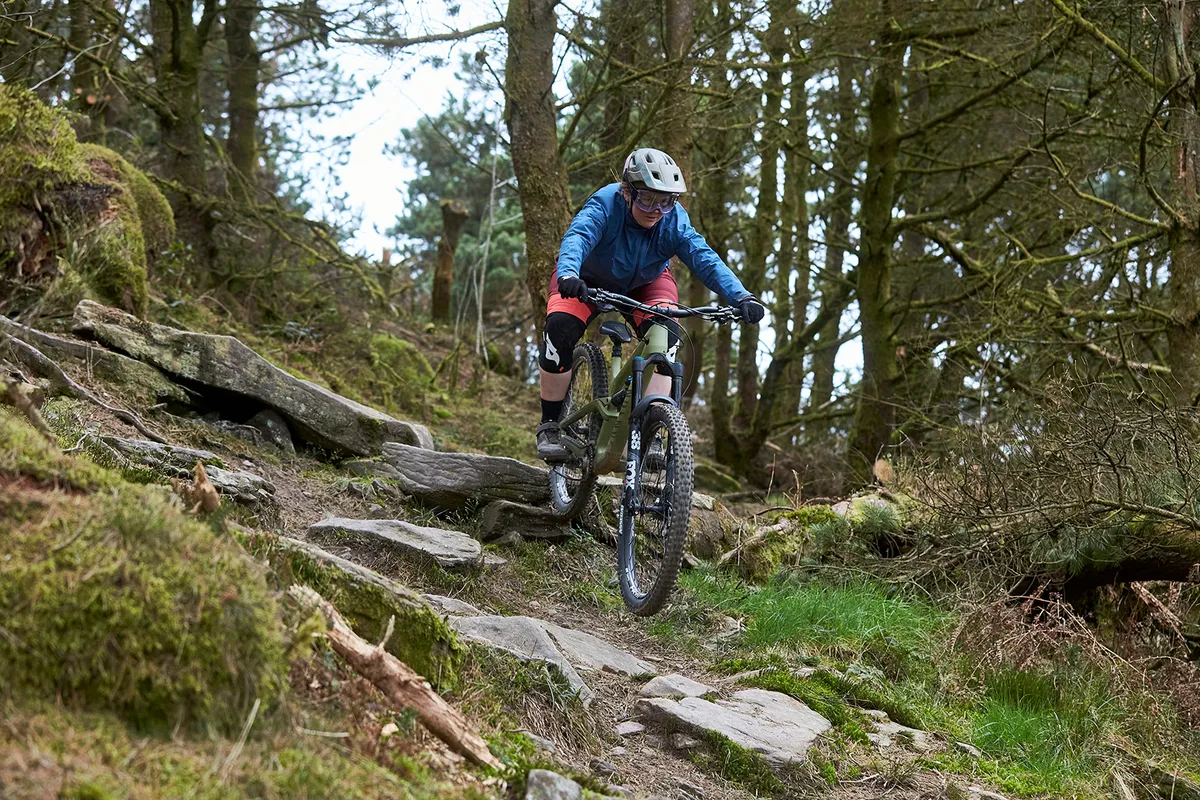
The Canyon Torque CF8 is masses of fun to ride and encourages you to boost off every undulation or lip in sight with the utmost confidence.
The well-balanced geometry and suspension make adapting to it a breeze and riding it fast, even on horrendously steep trails, a confident and composed experience.
While it doesn’t offer quite the same levels of grip or swallow the bumps in quite the same way as the best enduro bikes out there, it’s still one hell of a machine.
Enduro Bike of the Year 2022 | How we tested
Designing a high-performance enduro bike is all about balance.
While there’s no denying these bikes need to descend with the confidence and poise of a full-blown downhill bike, they still need to be pedalled back up to the top of the hill.
But, more than that, they also need to be built to last with components that can take a serious beating.
To be crowned as the best enduro bike on test, we were looking for a bike that felt pleasant enough on the climbs (no enduro bike will ever be a cross-country-like mountain goat!) and easy to ride fast when pointed back downhill.
Testing the bikes required a serious amount of riding over a 12-week period. The terrain needed to be varied, too. Testing included everything from steep, natural trails covered in roots and peppered with rocks and mud, through to faster, high-speed bike park tracks with wheel-destroying rock gardens and chunky jumps.
We rode all of the bikes on test back-to-back to pin down the differences and mixed up the order in which we rode the bikes to see just how each machine felt when we were fresh – and not so fresh.
Our 2022 Enduro Bike of the Year contenders are:
- Cannondale Jekyll 2
- Canyon Torque CF8
- GT Force Pro
- Marin Alpine Trail XR
- Nukeproof Giga 297 Carbon Elite
- Propain Tyee AL 29 Performance
- Santa Cruz Bronson C R
- Whyte G-180 RS MX
Thanks to…
Thanks to our sponsors MET Helmets, Bluegrass Protection and BikePark Wales for their support in making Bike of the Year happen.
Product
| Brand | canyon |
| Price | 7299.00 AUD,4799.00 EUR,4499.00 GBP,5399.00 USD |
| Weight | 15.8000, KILOGRAM (M) - without pedals |
Features
| Fork | Fox 38 Performance Elite GRIP2, 170mm (6.7in) travel |
| br_stem | Canyon G5, 40mm |
| br_chain | Shimano |
| br_frame | Carbon, 175mm (6.9in) travel |
| Tyres | Maxxis Assegai 3C MaxxTerra EXO+ 29x2.5in (fr)/Maxxis DHR II 3C MaxxGrip DD 27.5x2.4in (r) BB: Shimano MT800 |
| br_brakes | Shimano XT M8120 (203mm rotors) |
| br_cranks | Shimano XT |
| br_saddle | Fizik Gravita Alpaca |
| br_wheels | DT Swiss FR560 rims on 350 hubs |
| br_headset | Canyon |
| br_shifter | Shimano XT |
| br_cassette | Shimano XT |
| br_seatpost | Canyon G5, 170mm |
| br_gripsTape | Canyon G5 |
| br_handlebar | Canyon G5 Riser, 780mm |
| br_rearShock | Fox DHX2 Factory |
| br_bottomBracket | Shimano MT800 |
| br_availableSizes | M, L, XL |
| br_rearDerailleur | Shimano XT |
